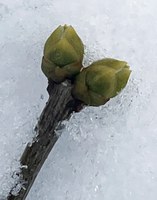Dakota Gardener: The only crystal ball I have is a snow globe
(Click an image below to view a high-resolution image that can be downloaded)
By Joe Zeleznik, Forester
NDSU Extension
I’ve been to a lot of parties over the last few weeks, getting together with neighbors and friends as we celebrated the holidays with one year ending and a new one just beginning. Some people made resolutions for self-improvement and others were already making plans for this year’s projects.
And a lot of people had questions about trees.
How are they responding to the warm December weather? What will the mild temperatures do to the insect pests that will attack trees next summer? Is Dutch elm disease going to be especially prevalent next year?
I have a lot of these same questions and have been trying to come up with answers. By late December, it looked like the buds on our lilac shrubs were expanding like they do in the spring. Surely that can’t be good for them, right?
But I have no crystal ball, and all I can do is make an educated guess. Also, there’s so much winter left that forecasting which trees will be damaged or undamaged would be like predicting the lottery winners.
I still expect that we’ll have temperatures in the negative teens or even negative 20s. Equally important are the questions, when will those temperatures arrive, how long will they last and how quickly will the temperatures drop? All these factors play a role in tree survival and insect survival.
Remember the “polar vortex” in 2014? Or the one in 2019? Some people were predicting that these events would kill all of the emerald ash borers and we wouldn’t have to worry about this invasive pest. Well, those predictions were wrong and EAB is in northern Minnesota. And it’s in Winnipeg, so that theory really, really didn’t hold water.
The other main winter-weather issue that trees face in North Dakota is the annual event that I like to call “the mid-winter fake out.” That’s when temperatures rise into the 50s or even 60s for a few days in February or March, then they drop back to normal. That brief warm-up causes many of our less-adapted trees to lose their hardiness and begin to become active.
This very situation happened back in 2021, when birch trees throughout the state died back because of an extreme warm-up that March. Then temperatures dropped back down and many European white birch and Asian white birch trees were toast.
And there was nothing we could do about it, just like our extremely warm December 2023.
On a related note (sort of), underneath the pine trees in my yard, there are two large totes that have screen mesh over their tops. Inside the totes are branches from larch trees that I collected in Larimore and Cooperstown last September. Those branches are infested with insect larvae that need to overwinter under the bark, to complete their development into adults. I’m hoping to rear out those insects and then collect the adults once they emerge. At this point, though, it’s also a question of if they emerge.
Regardless, I’ll wait it out, and in the spring, I’ll learn something new.
NDSU Agriculture Communication – Jan. 10, 2024
Source: Joe Zeleznik, 701-730-3389, joseph.zeleznik@ndsu.edu
Editor: Kelli Anderson, 701-231-7006, kelli.c.anderson@ndsu.edu





